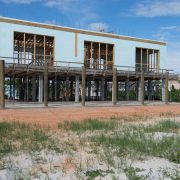The Benefits of ICF Construction

If you’ve decided that you want to build a custom home, you’ve probably done a lot of research about different methods of construction, including insulated concrete forms (ICF).
You may be wondering if building your new home as an ICF structure is the right thing for you and your pocketbook. That’s where we come in. At Bontrager Builders Group, we have expert knowledge of ICF and whether our clients should consider the method. Here’s a rundown of the most important ICF facts.
First, let’s talk about what ICF construction means. When an ICF home’s concrete walls are being built, blocks made of foam are stacked into air-tight patterns between the walls. These foam blocks are then filled with concrete and reinforced with steel, making the ICF home strong enough to stand up to most severe weather.
For example, take a look at the picture below that shows the interior of a few ICF foam blocks from one of our recent projects. This photo was taken before concrete was poured into the foam blocks, but it provides some insight into what the inside of an ICF home’s walls look like. The foam blocks fit together so well that there are hardly any gaps or openings to allow outside weather or material to enter the ICF home.

Besides the concrete, the steel skeleton provides added support to the home’s walls. In addition, any electrical or plumbing elements are run through the foam blocks before the concrete is poured into them. Because of the additional strength in poor weather conditions, ICF is the ideal method by which to construct beach homes. In the long run, ICF homeowners save money in damage control and energy.

Let’s talk a little more about the long-run savings that many ICF homeowners enjoy as a result of their chosen building technique. According to Proud Green Home, because the ICF method of insulation does not leave many gaps between the foam blocks, “an ICF home can cut energy bills in half and can achieve a HERS index in the 40-50 range, which means they are outperforming existing building codes by 50 to 60 percent.” Energy bills being cut in half means that ICF homeowners are benefiting in that they are saving a huge chunk of change by building their homes with foam bricks and concrete.
As a result of Florida’s often unpredictable and severe weather, many homeowners want to have a home that stands the test of time. The ICF method can help owners achieve that goal.

